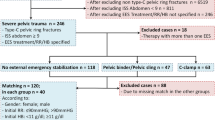Abstract
Objective:
Emergency stabilization of translationally unstable injuries/fractures of the pelvic ring (type C injuries). Temporary, rarely definitive, restoration of form and function of the posterior pelvis.
Indications:
Emergency stabilization of sacroiliac disruptions and fractures of the sacrum in type C pelvic injuries. Type B injuries with clinically apparent instability (rotational instability) and type C injuries (disruption of sacroiliac joint, fractured sacrum) with associated circulatory instability.
Contraindications:
Pelvic type A fractures. Pelvic fractures involving the iliac wing(s). Rotational instability of the pelvis without associated circulatory instability (type B).
Surgical Technique:
Closed reduction applying traction, pressure and rotation to the affected hemipelvis. Stab incisions and bilateral percutaneous introduction of the pins. Compression of the C-clamp under fluoroscopic monitoring stabilizes the posterior pelvic ring. Depending upon the patient’s general condition, open reduction and internal fixation (ORIF) will often be performed at a later time.
Results:
39 patients with type C pelvic injuries underwent primary stabilization with the pelvic C-clamp. The patients’ average age was 36 years (11–89 years), 29 were men, ten woman. With the exception of two, all patients had sustained either multiple injuries, or polytrauma. The mean Hannover Polytrauma Score (HPS) was 39.9 points (11–79 points). Ten patients had a disrupted sacroiliac joint, 29 an unstable fracture of the sacrum. On admission, all patients with the exception of four were considered hemodynamically unstable. The initial hemoglobin count was 6.7 g/dl (3.1–12.3 g/dl) on average, the average base excess amounted to –8.7 mmol/l (+2 to –28.0 mmol/l), average systolic blood pressure on admission was 82 mmHg (0–130 mmHg), corresponding to marked findings of shock. At the time of C-clamp application, the indication for the C-clamp was a pelvic instability in 13 patients alone, and in 26 patients the pelvic instability was associated with a circulatory instability. In 15 patients the circulatory situation stabilized after application of the C-clamp. Complications occurred in seven patients (excessive compression of sacral fractures in three patients, one pin malpositioning, two bleeders from pin channels, one perforation of the ilium). This reflects a steep learning curve.
Similar content being viewed by others
Author information
Authors and Affiliations
Corresponding author
Additional information
The following is a reprint from Operat Orthop Traumatol 2004;16:192–204 and continues the new series of articles at providing continuing education on operative techniques to the European trauma community.
Reprint from: Operat Orthop Traumatol 2004;16:192–204 DOI 10.1007/s00064-004-1101-3.
Rights and permissions
About this article
Cite this article
Gänsslen, A., Krettek, C. & Pohlemann, T. Emergency Stabilization of Pelvic Instabilities with the Pelvic C-Clamp. Eur J Trauma 30, 412–419 (2004). https://doi.org/10.1007/s00068-004-1101-x
Issue Date:
DOI: https://doi.org/10.1007/s00068-004-1101-x




